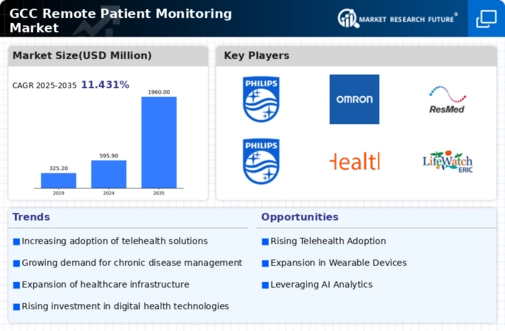Government Initiatives and Funding
Government initiatives and funding play a pivotal role in shaping the remote patient-monitoring market in the GCC. Various governments in the region are actively promoting digital health solutions to enhance healthcare delivery and efficiency. Initiatives aimed at integrating technology into healthcare systems are being launched, with substantial financial backing. For instance, the Saudi Arabian government has allocated significant funds to support telehealth and remote monitoring projects. Such initiatives are likely to foster innovation and encourage the development of new technologies within the remote patient-monitoring market. As a result, the market is expected to expand rapidly, with projections indicating a growth rate of around 12% over the next few years, driven by government support and funding.
Growing Prevalence of Chronic Diseases
The rising prevalence of chronic diseases in the GCC region is a critical driver for the remote patient-monitoring market. Conditions such as diabetes, hypertension, and cardiovascular diseases are becoming increasingly common, necessitating continuous monitoring and management. The remote patient-monitoring market provides an effective solution for managing these chronic conditions, allowing healthcare providers to track patients' health metrics remotely. This capability is particularly beneficial in a region where lifestyle-related diseases are on the rise. According to recent statistics, chronic diseases account for nearly 70% of total healthcare expenditures in the GCC. Consequently, the demand for remote monitoring solutions is expected to grow, as they offer a cost-effective approach to managing chronic diseases and improving patient outcomes.
Integration of Artificial Intelligence
The integration of artificial intelligence (AI) into the remote patient-monitoring market is transforming the landscape of healthcare in the GCC. AI technologies are being utilized to analyze patient data more effectively, enabling healthcare providers to make informed decisions. This integration enhances the accuracy of monitoring systems, allowing for real-time data analysis and timely interventions. As a result, healthcare providers can offer personalized care plans tailored to individual patient needs. The remote patient-monitoring market is likely to see a significant increase in AI-driven solutions, with estimates suggesting that AI could reduce healthcare costs by up to 20% while improving patient outcomes. This technological advancement is expected to attract more investments and drive the growth of the remote patient-monitoring market.
Rising Demand for Healthcare Accessibility
The remote patient-monitoring market is experiencing a notable surge in demand for enhanced healthcare accessibility across the GCC region. This trend is driven by a growing population that increasingly seeks convenient healthcare solutions. As urbanization continues to rise, the need for efficient healthcare delivery mechanisms becomes paramount. The remote patient-monitoring market is poised to benefit from this shift, as it offers patients the ability to receive care from the comfort of their homes. Furthermore, the GCC governments are investing in digital health initiatives, which are expected to increase the adoption of remote monitoring technologies. This investment is likely to lead to a projected growth rate of approximately 15% annually in the remote patient-monitoring market, reflecting the region's commitment to improving healthcare access.
Increased Awareness of Preventive Healthcare
There is a growing awareness of preventive healthcare among the population in the GCC, which is significantly influencing the remote patient-monitoring market. As individuals become more health-conscious, they are seeking proactive measures to manage their health. Remote monitoring technologies enable patients to track their health metrics, facilitating early detection of potential health issues. This shift towards preventive care is likely to drive the adoption of remote patient-monitoring solutions, as they empower patients to take charge of their health. The remote patient-monitoring market is expected to benefit from this trend, with estimates suggesting that the demand for preventive healthcare solutions could increase by approximately 18% in the coming years. This heightened awareness is indicative of a broader cultural shift towards prioritizing health and wellness.

















Leave a Comment